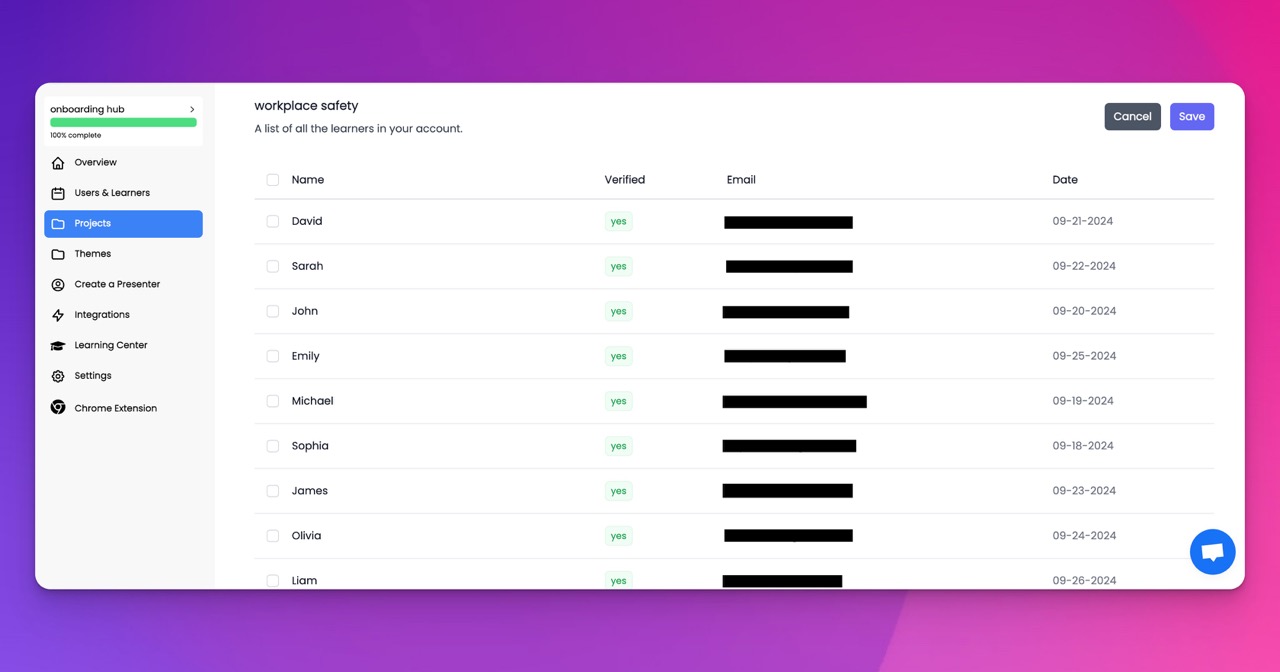🎉 Trainday now integrates with Zendesk and Hubspot 🎉 Trainday now integrates with Zendesk and Hubspot 🎉 Trainday now integrates with Zendesk and Hubspot
🎉 Trainday now integrates with Zendesk and Hubspot
🎉 Trainday now integrates with Zendesk and Hubspot
Contact
Faster, Smarter, Safer: The AI Advantage in Safety Training Programs
In today’s dynamic workplace environment, safety training must do more than meet regulatory requirements—it must be efficient, adaptive, and impactful. Traditional methods of safety training often struggle to keep pace with evolving risks and diverse workforce needs. That’s where artificial intelligence (AI) steps in, revolutionizing how safety training is designed, delivered, and optimized.
AI brings speed, precision, and intelligence to safety training programs, helping organizations build faster, smarter, and safer workplaces. At Trainday, we leverage AI to empower businesses with training solutions that are not only compliant but also engaging and transformative.
The Challenges of Traditional Safety Training
Many organizations rely on outdated safety training methods that fail to address today’s challenges:
Generic Content: One-size-fits-all training doesn’t address the unique risks of different roles or industries.
Time-Intensive Processes: Developing and delivering training can take weeks or months, delaying employee readiness.
Limited Engagement: Static and uninspiring training formats lead to low retention rates and poor outcomes.
Reactive Approach: Traditional programs often respond to past incidents rather than proactively addressing emerging risks.
The AI Advantage in Safety Training
AI brings game-changing capabilities to safety training, making programs faster, smarter, and safer than ever before.
1. Faster Training Development
AI automates the creation of training materials, reducing the time it takes to develop and deploy programs. For example:
AI-powered platforms like Trainday can transform data sources—such as incident reports, audits, and manuals—into interactive training modules in minutes.
Prebuilt templates and AI-driven content generation allow organizations to roll out training quickly, even in response to unexpected risks or regulatory changes.
2. Smarter Personalization
AI analyzes employee roles, tasks, and risk data to deliver personalized training content tailored to each individual’s needs. This ensures:
Relevance: Employees only receive training on topics applicable to their role.
Engagement: Custom scenarios and examples resonate more with employees, improving retention.
Efficiency: Employees spend less time on unnecessary training, focusing only on what matters most.
3. Safer Workplaces Through Predictive Analytics
AI uses predictive analytics to identify risks before they lead to incidents. By analyzing patterns in incident reports, audit findings, and employee feedback, organizations can:
Spot high-risk areas or behaviors.
Implement preventive measures proactively.
Deliver training that addresses potential hazards before they occur.
4. Real-Time Feedback and Adaptation
AI enables real-time monitoring of training effectiveness. Key features include:
Adaptive learning pathways that adjust based on employee progress.
Instant feedback on quizzes and assessments to reinforce critical concepts.
Continuous updates to training content based on the latest data and risks.
5. Enhanced Reporting and Compliance
AI-powered platforms simplify compliance with real-time reporting and automated recordkeeping. This includes:
Tracking training completion rates and knowledge retention.
Generating audit-ready documentation for OSHA and other regulatory bodies.
Flagging areas of non-compliance for immediate corrective action.
Benefits of AI-Powered Safety Training
1. Accelerated Onboarding
New hires can quickly get up to speed with fast, role-specific training that ensures they’re ready to contribute safely from day one.
2. Higher Engagement and Retention
Interactive, personalized content keeps employees engaged, resulting in better knowledge retention and application.
3. Reduced Incident Rates
By proactively addressing risks and tailoring training to specific hazards, organizations see a measurable reduction in workplace accidents.
4. Cost Savings
AI reduces the time and resources needed to develop and deliver training, while minimizing costs associated with workplace injuries and compliance penalties.
5. Scalable Solutions
AI-powered training grows with your business, adapting to the needs of a larger workforce or more complex safety requirements.
How to Implement AI in Safety Training
Step 1: Assess Your Current Training Program
Identify gaps, inefficiencies, and areas where traditional methods fall short.
Step 2: Gather Data
Collect data from incident reports, employee feedback, and audits to inform your AI-driven training strategy.
Step 3: Choose the Right Platform
Select an AI-powered training solution like Trainday that integrates seamlessly with your existing processes and delivers personalized, data-driven training.
Step 4: Deploy and Monitor
Roll out AI-driven training and track its impact using real-time analytics. Adjust and refine as needed to maximize results.
Step 5: Engage Employees
Communicate the benefits of AI-powered training to employees, emphasizing how it makes their work safer and more efficient.
How Trainday Can Help
At Trainday, we specialize in helping businesses harness the power of AI to revolutionize safety training. Our platform offers:
Customizable Training Modules: Tailored to specific roles, industries, and risks.
Real-Time Analytics: Monitor progress, track compliance, and measure effectiveness with ease.
Proactive Risk Mitigation: Use predictive insights to address hazards before they become incidents.
Rapid Deployment: Develop and launch training programs in hours, not weeks.
With Trainday, you can create faster, smarter, and safer safety training programs that protect your workforce and drive better outcomes.
Final Thoughts
AI is transforming workplace safety training, making it more efficient, engaging, and effective. By adopting an AI-driven approach, organizations can ensure compliance, reduce risks, and empower employees to work smarter and safer.
Ready to revolutionize your safety training? Visit Trainday.com to learn how our AI-powered solutions can help you build a faster, smarter, and safer workplace. Let’s take your training to the next level!
Accelerate Compliance.
Deliver OSHA-Ready Courses Instantly.
Empower your team with data-driven training solutions tailored to your industry's safety standards. Stay compliant, reduce risks, and boost productivity with AI-powered course creation.
